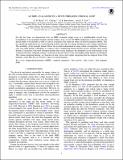Files in this item
An MHD avalanche in a multi-threaded coronal loop
Item metadata
| dc.contributor.author | Hood, Alan William | |
| dc.contributor.author | Cargill, Peter | |
| dc.contributor.author | Browning, Philippa | |
| dc.contributor.author | Tam, Kuan | |
| dc.date.accessioned | 2016-01-22T12:40:11Z | |
| dc.date.available | 2016-01-22T12:40:11Z | |
| dc.date.issued | 2016-01-20 | |
| dc.identifier | 236677791 | |
| dc.identifier | 5bcca8bc-785a-480b-94f1-59dcf071e14d | |
| dc.identifier | 84955488284 | |
| dc.identifier | 000368872400005 | |
| dc.identifier.citation | Hood , A W , Cargill , P , Browning , P & Tam , K 2016 , ' An MHD avalanche in a multi-threaded coronal loop ' , Astrophysical Journal , vol. 817 , no. 1 , 5 , pp. 1-7 . https://doi.org/10.3847/0004-637X/817/1/5 | en |
| dc.identifier.issn | 0004-637X | |
| dc.identifier.other | ORCID: /0000-0003-2620-2068/work/58055234 | |
| dc.identifier.uri | https://hdl.handle.net/10023/8061 | |
| dc.description | We acknowledge the financial support of STFC through the Consolidated grants to the University of St Andrews and the University of Manchester. | en |
| dc.description.abstract | For the first time, we demonstrate how an MHD avalanche might occur in a multithreaded coronal loop. Considering 23 non-potential magnetic threads within a loop, we use 3D MHD simulations to show that only one thread needs to be unstable in order to start an avalanche even when the others are below marginal stability. This has significant implications for coronal heating in that it provides for energy dissipation with a trigger mechanism. The instability of the unstable thread follows the evolution determined in many earlier investigations. However, once one stable thread is disrupted, it coalesces with a neighboring thread and this process disrupts other nearby threads. Coalescence with these disrupted threads then occurs leading to the disruption of yet more threads as the avalanche develops. Magnetic energy is released in discrete bursts as the surrounding stable threads are disrupted. The volume integrated heating, as a function of time, shows short spikes suggesting that the temporal form of the heating is more like that of nanoflares than of constant heating. | |
| dc.format.extent | 7 | |
| dc.format.extent | 1740209 | |
| dc.language.iso | eng | |
| dc.relation.ispartof | Astrophysical Journal | en |
| dc.subject | Magnetohydrodynamics (MHD) | en |
| dc.subject | Methods: numerical | en |
| dc.subject | Sun: activity | en |
| dc.subject | Sun: corona | en |
| dc.subject | Sun: magnetic fields | en |
| dc.subject | QB Astronomy | en |
| dc.subject | QA Mathematics | en |
| dc.subject | QC Physics | en |
| dc.subject | NDAS | en |
| dc.subject | BDC | en |
| dc.subject | R2C | en |
| dc.subject.lcc | QB | en |
| dc.subject.lcc | QA | en |
| dc.subject.lcc | QC | en |
| dc.title | An MHD avalanche in a multi-threaded coronal loop | en |
| dc.type | Journal article | en |
| dc.contributor.sponsor | Science & Technology Facilities Council | en |
| dc.contributor.sponsor | Science & Technology Facilities Council | en |
| dc.contributor.sponsor | Science & Technology Facilities Council | en |
| dc.contributor.institution | University of St Andrews. School of Mathematics and Statistics | en |
| dc.identifier.doi | 10.3847/0004-637X/817/1/5 | |
| dc.description.status | Peer reviewed | en |
| dc.identifier.grantnumber | ST/K000950/1 | en |
| dc.identifier.grantnumber | ST/L005522/1 | en |
| dc.identifier.grantnumber | ST/N000609/1 | en |
This item appears in the following Collection(s)
Items in the St Andrews Research Repository are protected by copyright, with all rights reserved, unless otherwise indicated.

